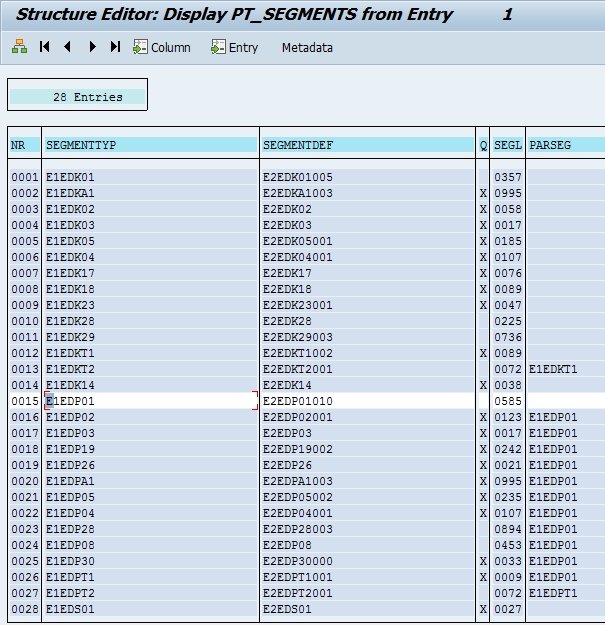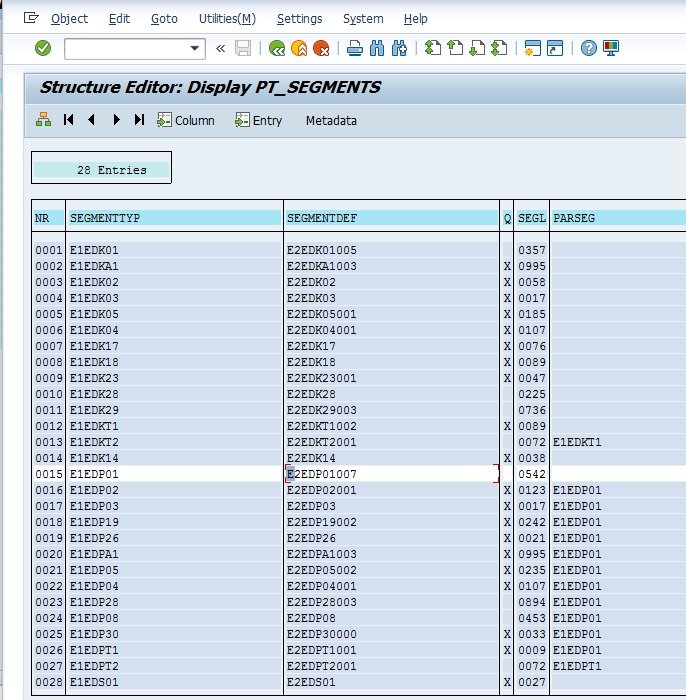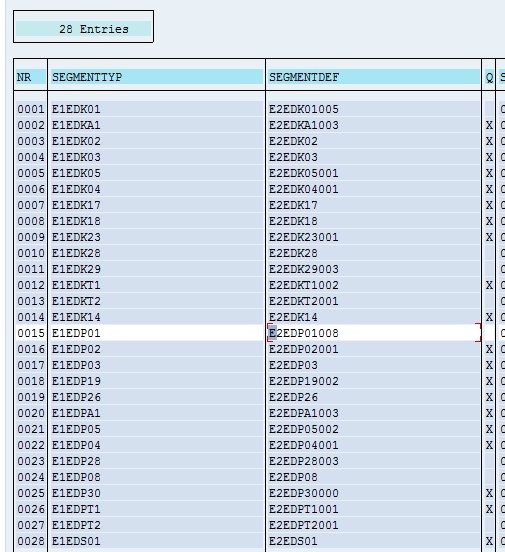Identifying SAP ERP Logon Parameters
|
Topics: |
This section allows you to identify SAP ERP logon parameters, which are used to configure a connection to SAP ERP using the iWay Application Adapter for SAP ERP. This information can be used as a reference.
User Parameters
The following table lists and describes user parameters that are located in the User tab.
|
Parameter |
Description |
Example |
Comment |
|---|---|---|---|
|
Client |
Identifies the SAP ERP client. |
800 |
A self-contained unit in a SAP ERP system with separate master records and its own set of tables. A client can, for example, be a corporate group. |
|
User |
SAP ERP login ID. |
abc123 |
It is recommended to use an SAP communication type ID. |
|
Password |
Confidential authentication information. |
xyz999 |
A word or string of characters that identifies or authenticates a user for access to a SAP ERP system. |
|
Language |
Language |
E |
When you log onto the SAP ERP system, you must select a valid installed language. |
|
Codepage |
A valid SAP ERP code page (normally, do not set this parameter as conversions are done automatically). If you select an unknown codepage, the RFC terminates with the error SYSTEM_FAILURE. |
|
Specify an initial, logon codepage. It is immediately changed by the SAP ERP client into the automatically detected version, depending on the locale information available to SAP JCo. |
|
Authentication Mode |
How the connection is validated. |
See the next column for available options. |
Note: The user and password parameters that are mentioned here refer to the User and Password parameter fields in iWay Explorer. |
System (Application Server) Parameters
The following table lists and describes system parameters that are located in the System tab when defining an Application Server target type.
|
Parameter |
Description |
Example |
Comment |
|---|---|---|---|
|
Application Server |
Connects to an ABAP application server. |
iwjpsap |
Application programs in an R/3 system are run on application servers. To obtain metadata information, a connection to an application server is required. |
|
System Number |
Identifies a unique instance on the application server. |
00 |
An application server may have different system numbers. Use the one provided by your administrator. |
|
Explicit commit |
Calls the BAPI_TRANSAC- TION_COMMIT function after every function call in the adapter. |
true/false |
Use this functionality only if you require explicit commit functionality as it can add to processing time. This command enables commit asynchronously. The commit function is called and returns immediately. It is still possible for the database commit to fail, but no notification would be received. This command is the equivalent to the COMMIT WORK ABAP statement. |
System (Message Server) Parameters
The following table lists and describes system parameters that are located in the System tab when defining a Message Server target type.
|
Parameter |
Description |
Example |
Comment |
|---|---|---|---|
|
Message Server |
Connects to an ABAP application server. |
iwjpsap |
For load balancing purposes, application servers from one SAP ERP system are usually configured in logon groups, where each group serves a particular kind of user. The message server is responsible for communication between the application servers. It passes requests from one application server to another within the system. It also contains information about application server groups and the current load balancing within them. It uses this information to choose an appropriate server when a user logs onto the system. |
|
R/3 Name |
Identifies a unique instance. |
P47 |
Symbolic SAP ERP system name used to identify the system. |
|
Server Group |
Identifies the logon group. |
Logon group that the user ID belongs with. |
Connection Pool Parameters
The following table lists and describes connection pool parameters that are located in the System tab.
|
Parameter |
Description |
Example |
Comment |
|---|---|---|---|
|
Connection pool size |
Maximum number of connections for the pool. |
2 |
Sets the maximum number of connections that can be allocated from the pool. |
|
Connection timeout(min) |
Maximum time to keep open a free connection (in minutes). |
10 (minutes) |
Connections that have not been used for at least the connection timeout interval will be closed. |
|
Connection wait time(sec) |
Maximum wait for a free connection. |
30 (seconds) |
Sets the maximum time to wait in a connection request for a free connection. If the pool is exhausted, and there is still no connection available after the specified time, a JCO.Exception with the key JCO_ERROR_RESOURCE will be thrown. The default value is 30 seconds. |
SAP ERP Gateway Parameters
The following table lists and describes SAP ERP Gateway parameters that are located in the System tab when defining a Message Server target type.
|
Parameter |
Description |
Example |
Comment |
|---|---|---|---|
|
Gateway host |
Enter the name of a SAP ERP Gateway server. |
isdsrv2 |
The SAP ERP Gateway carries out CPI-C services within the SAP ERP world, which are based on TCP/IP. These services enable SAP ERP systems and external programs to communicate with one another. |
|
Gateway service |
Enter the service name (usually a compound of the service name and system number). |
Sapgw00 |
Service name on the gateway host. |
ALE Parameters
|
Topics: |
The following table lists and describes ALE parameters.
|
Parameter |
Description |
Example |
Comment |
|---|---|---|---|
|
EDI Version |
Specifies the ALE version of the target system. |
3 |
Version 3 (Release 4.0 onwards) should be selected in the port description for all R/3 partner systems with Release 4.0 or higher. Version 2 (release 3.0/3.1) must be set in the port description for all R/3 partner systems with releases lower than 4.0. |
|
IDOC Release |
Specifies the version in which the IDOC definition was released. |
Blank or a specific SAP ERP release version (for example, 46C). |
You can assign segment definitions from previous releases to an IDoc type in the current release. This may be necessary if, for example, the partner is using an older release which supports your current IDoc type, but not your current segment definitions. |
|
IDOC Release Provider |
Specifies where the adapter will retrieve the release information. |
See the next column for available options. |
|
Understanding the User Input Option for the IDOC Release Provider Parameter
The User Input option for the IDOC Release Provider parameter uses the IDOC release field directly to retrieve this information.
Issues with receiving IDOCs through the adapter can occur when using a segment in the IDOC with a segment release version that is not the default metadata release for the targeted SAP system.
The segment metadata is retrieved for each segment in order. For example, for segment type E1EDP01 of IDOC Invoic02 in release 740, the segment definition is E2EDP01010, not E2EDP008.

Entering a value of 700 would not work because the release level of the segment definition for 700 is E2EDP01007.
The correct release level is 730 for E2EDP01008.
Leaving the IDOC Release Provider parameter and the IDOC release number empty resolves the issue, however, this workaround is not related to the adapter. It is a property of the SAP system.
When the IDOC release is set to blank (" "), the function on SAP that executes provides the highest version of the metadata and does not check for an exact match. Unless you know the exact release installed on your SAP system, specifying the User Input option for the IDOC Release Provider parameter and leaving the IDOC Release parameter blank is the only possible solution when the IDOC data does not match the IDOC metadata.
Using the highest version of the metadata is generally harmless, as SAP adds new fields at the end of the metadata record, and the metadata is parsed only when there is data.
The following image shows a segment ending in 731 for release 731.

The following image shows a segment ending in 811 for release 700.

Global Processing Parameters
The following table lists and describes global processing parameters that are located in the Advanced tab.
|
Parameter |
Description |
Example |
Comment |
|---|---|---|---|
|
Error Handling |
Specifies the error handling method of the adapter. |
See the next column for available options. |
|
|
Commit with Wait |
Specifies the commit behavior. |
See the next column for available options. |
|
|
SAP trace |
Enables the SAP ERP Java connectors trace behavior. |
See the next column for available options. |
|
|
Trace level |
Indicates the level of detail in the SAP ERP traces. |
5 |
Select a value that ranges from 0 through 10 from the drop-down list. |
SNC Parameters
The following table lists and describes the security (SNC) parameters that are located in the Security tab.
|
Parameter |
Description |
Example |
Comment |
|---|---|---|---|
|
SNC mode |
Flag for activating SNC. |
1 (on) |
Required. |
|
SNC partner |
Specifies the application server's SNC name. |
p:CN=ABC, O=MyCompany C=US |
You can find the SNC name of the application server in the profile parameter snc/identity/as. |
|
SNC level |
Specifies the level of protection to use for the connection. |
See the next column for available options. |
|
|
SNC name |
Specifies SNC name. |
p:CN=SAPJ2EE O=MyCompany, C=US |
Although this parameter is optional, it is not recommended for use to ensure that the correct SNC name is used for the connection. |
|
SNC library path |
Specifies the path and file name of the external library. |
C:\SAPJ2EE_ Engine\SAPCrypto- lib\sapcrypto.dll |
The default is the system-defined library as defined in the SNC_LIB environment variable. |